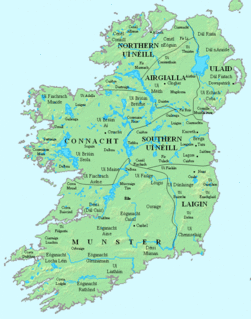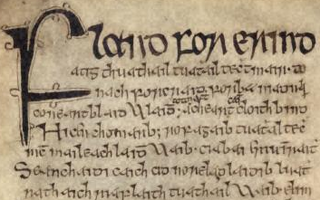Cathal mac Conchobair Ruadh Ua Conchobair was King of Connacht in Ireland. He was a member of the Clan Muircheartaigh Uí Conchobhair lineage.
Cathal mac Domhnall Ó Conchobair was King of Connacht from 1318 to 1324. The Kings of Connacht were rulers of the cóiced of Connacht, which lies west of the River Shannon, Ireland. However, the name only became applied to it in the early medieval era, being named after The Connachta.
Aedh mac Aedh Breifneach Ua Conchobair was king of Connacht in 1342. He was the last of the Clan Muircheartaigh Uí Conchobhair to hold this position. He died in 1350, as the Ó Conchobar Brefnech, some eight years after being expelled. His father, a son of Cathal Ruadh Ó Conchobair had briefly made a bid for the kingship in 1309-10 from a power-base established in Bréifne Ó Ruairc.
Cathal mac Conchobair was King of Connacht.
Muirchertach Nár mac Guairi was a possible King of Connacht from the Ui Fiachrach Aidhne branch of the Connachta. He was the son of Guaire Aidne mac Colmáin, famous in Irish sagas.
Cenn Fáelad mac Colgan was a King of Connacht from the Uí Briúin branch of the Connachta. He was of the branch which developed into the Uí Briúin Seóla, who were centred on Tuam in modern County Galway. He is the first member of this branch mentioned in the annals.
Muiredach Muillethan mac Fergusso was a King of Connacht from the Uí Briúin branch of the Connachta. He was the grandson of Rogallach mac Uatach, a previous king. He belonged to the Uí Briúin Ai sept. His sobriquet Muillethan means "broad-crowned".
Domnall mac Cathail was a possible King of Connacht from the Uí Briúin branch of the Connachta. He was the son of Cathal mac Rogallaig and grandson of a previous king Rogallach mac Uatach.
Indrechtach mac Muiredaig Muillethan was a King of Connacht from the Uí Briúin branch of the Connachta. He was the son of Muiredach Muillethan mac Fergusso, a previous king. He was of the Síl Muiredaig sept of the Uí Briúin.
Forggus mac Cellaig was a King of Connacht from the Uí Briúin branch of the Connachta. He was the son of Cellach mac Rogallaig, a previous king and brother of Domnall mac Cellaig. The sept of Uí Briúin Ai he belonged to was the Síl Cellaig of Loch Cime named for his father. He reigned from 742 to 756.
Conchobar mac Taidg Mór was a King of Connacht from the Uí Briúin branch of the Connachta. He was the grandson of Muirgius mac Tommaltaig, a previous king. His father Tadg Mór had been slain fighting in Muirgius' wars versus the minor tribes of Connacht. He was of the Síl Muiredaig sept of the Uí Briúin. The Ó Conchobhair septs of Connacht are named for him.
Áed mac Conchobair was a King of Connacht from the Uí Briúin branch of the Connachta. He was the son of Conchobar mac Taidg Mór, the previous king and was the first of his three sons to rule in succession. He was of the Síl Muiredaig sept of the Uí Briúin. He ruled from 882-888.
Diarmait mac Tommaltaig was a king of Connacht from the Uí Briúin branch of the Connachta. He was the great-grandson of Indrechtach mac Muiredaig Muillethan, a previous king. The death of his father Tommaltach mac Murgail is recorded in the annals where he is called king of Mag nAi. He succeeded his brother Muirgius mac Tommaltaig. He was of the Síl Muiredaig sept of the Uí Briúin. He ruled from 815 to 833.
Cathal mac Muirgiussa was a King of Connacht from the Uí Briúin branch of the Connachta. He was the son of Muirgius mac Tommaltaig, a previous king. He was of the Síl Muiredaig sept of the Uí Briúin. He ruled from 833–839 succeeding his uncle Diarmait mac Tommaltaig.
Murchad mac Áedo was a King of Connacht from the Uí Briúin branch of the Connachta. He reigned from 839-840.
Fergus mac Fothaid was a King of Connacht from the Uí Briúin branch of the Connachta. He reigned from 840-843.
Domnall mac Muirecáin was a King of Leinster of the Uí Fáeláin sept of the Uí Dúnlainge branch of the Laigin. This sept had their royal seat at Naas in the eastern part of the Liffey plain, Airthir Liphi. He was the son of Muirecán mac Diarmata, a previous king.
Creassa inion Urchadh Princess of the Uí Briúin Seóla and Queen of Connacht, fl. early 10th century.
Aedh mac Tairdelbach Óg Ó Conchobair, was one of the sons of Toirdhealbhach Óg Donn Ó Conchobair and King of Connacht from 1439–1461. Aedh Ó Conchobair succeeded to the throne of the Connachta in 1439 after the death of Cathal mac Ruaidri Ó Conchobair and was succeeded by Fedlim Ó Conchobair, also a son of Toirdhealbhach Óg Donn Ó Conchobair.
Fedlim Geancach Ó Conchobair was an Irish monarch of the fifteenth century. He was one of the sons of Toirdhealbhach Óg Donn Ó Conchobair and King of Connacht from 1461–1475. Fedlim Geancach Ó Conchobair succeeded to the throne of the Connachta in 1461 after the death of Aedh mac Tairdelbach Óg Ó Conchobair. Fedlim was the last fully recognized monarch of The Kingdom of Connacht.



